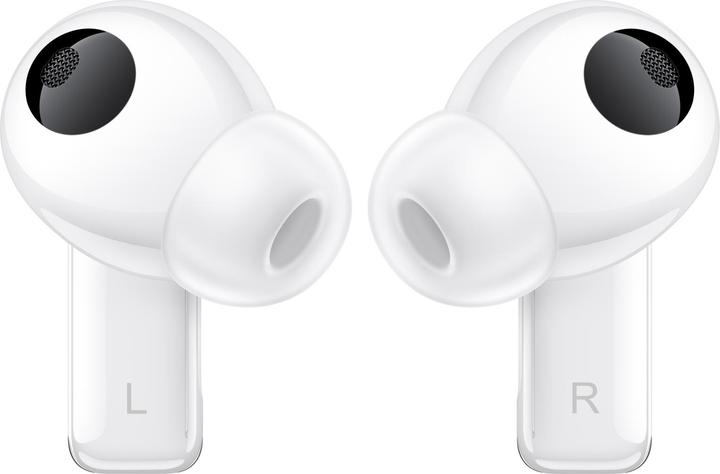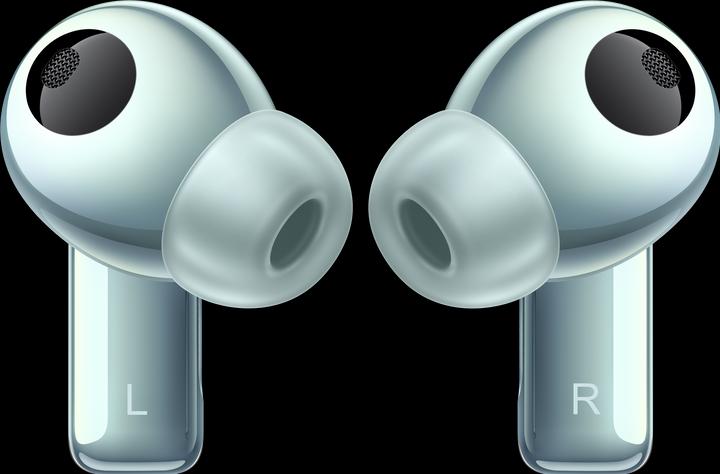

Huawei Freebuds Pro 3 review: slight enhancements made to very good earphones
The Huawei Freebuds Pro 3 are supposedly even better than their predecessors. Before starting my review, I found that hard to imagine. But after seeing the minor improvements made to the earphones for myself, I discover it really is true.
I liked the last version of Huawei’s Freebuds Pro [so much]/page/huawei-freebuds-pro-2-im-test-sehr-gut-aber-nicht-guenstig-24575that I’m left wondering how the Freebuds Pro 3 could possibly be any better. In the end, it’s minor improvements to the design, battery life and clarity of sound during phone calls that win me over. That said, they don’t completely blow previous models out of the water.
The Freebuds Pro 3 might suit you if you have very small ears or a narrow ear canal; Huawei includes rubber attachments in size XS as a fourth option. When I try the M size, they sit well and get a green light from the fit test I conduct via the app.
Most smartphones should recognise the Freebuds as soon as you open the case. If that doesn’t work, press and hold the button on the right-hand side of the charging cradle until pairing mode is activated. The earphones use Bluetooth 5.2 and support four codecs: L2HC, LDAC, AAC and SBC.
Rain and sweat can’t damage the Freebuds Pro 3. However, their IP54 certification won’t prevent them from feeling slightly looser in damp conditions.
Controls: pinching, swiping and an app
You can still control the Freebuds Pro 3 with pinching and swiping motions. This time, however, you can feel the area where the gestures are registered. Huawei has given the earphones a little recess so you know where you’re supposed to press them. Mind you, I didn’t have any trouble hitting the right spot when using the last model.

Source: Jan Johannsen
Gestures such as tapping once, tapping several times or pressing and holding allow you to do the usual headphone stuff: start and stop, skip to the next or previous song, answer or end calls and activate or deactivate noise cancelling. By swiping the earphones, you can adjust the volume.
Huawei also uses its AI Life app for the Freebuds Pro 3, which you can use to manage other devices such as routers or speakers. Bear in mind that you won’t find it in the Play Store. Instead, you’ll have to download it using the QR code on the Freebuds’ packaging. This makes the installation slightly cumbersome.

Source: Jan Johannsen
Like with touch operation, you can choose between noise cancelling and awareness mode in the app. If you go for awareness mode, the Freebuds will intentionally let in sounds from your surroundings. Alternatively, you can leave both modes switched off. In which case, you’ll only hear the background noise able to penetrate the attachments. When it comes to the rest of the features, there’s no alternative outside the app.
This includes six sound effects (standard, bass boost, treble boost, voices, symphony and Hi-Fi live) and the option to create your own sound effects. You can do this using the equaliser, which has ten frequency bands and thirteen levels.

Source: Jan Johannsen
The AI Life app also allows you to update the firmware of the Freebuds, find them if you’ve registered them in Huawei’s search system or adjust the gesture control. Other options include the attachment fit test mentioned above, as well as the option to activate wear detection and low audio latency. Activating wear detection automatically pauses playback when you take the earphones out. Meanwhile, low audio latency is designed to prevent choppy connections during heavy network usage.
Nice sound and more clarity
Huawei has installed two drivers in the Freebuds Pro 3, breaking with the typical practice of giving small earphones only one speaker. The Freebuds Pro 3 have an 11 mm bass driver, as well as a micro-planar speaker responsible for high audio frequencies. Huawei has also been touting its triple adaptive EQ – an equaliser that can adapt its settings to the shape of the ear canal.
That looks impressive on the data sheet, but how does it sound in real life? Great, if you ask me. And I said exactly the same about the previous model. On the other hand, I do think the Freebuds Pro 3 have a slightly more powerful bass than the [Freebuds Pro 2]/page/huawei-freebuds-pro-2-im-test-sehr-gut-aber-nicht-guenstig-24575. It packs quite the punch without drowning out voices. As is typical of earphones this size, however, you can hear the bass but not feel it.

Source: Jan Johannsen
Again, the highs are clear and crisp. I can easily distinguish between different instruments. When listening to radio plays, I can also make out subtle background noises. And certainly voices, regardless of whether they’re singing or speaking. I only struggle to make out what some of my Swiss colleagues are saying when they slip right into their dialect.
Despite all the praise, I’d still only rank the Freebuds Pro 3 number two in terms of sound quality. In my view, they’re eclipsed by the Nothing Ear (2), which sound a tad better.

Source: Jan Johannsen
If you want to use the Freebuds Pro 3 for phone calls, I have good news: your conversation partner will hear you more clearly compared to the last model. At least, that’s what people say in phone or video calls with me. The three microphones in the earphones and the voice pick-up unit (VPU) seem to have done some good. When you speak, the VPU picks up the sound directly at the bone, using software to make your spoken words sound clearer.
The same thing happens when it’s windy. Supposedly, the Freebuds Pro 3 are 80 per cent better at filtering out the sound of wind when you’re speaking. While I can’t confirm that figure, I can at least say that I no longer have to get off my bike to make a phone call when it’s windy. Of course, I didn’t have noise cancellation activated when I was on my bike.
Less is more
The Freebuds Pro 3’s active noise cancellation (ANC) is very good. Whether I’m surrounded by road traffic, the whirr of aeroplane turbines or my colleagues in the office, the earphones blanket me in silence. Even a little more so the previously model did. Huawei says the ANC has improved by 50 per cent.
Intelligent Dynamic ANC 3.0 supposedly played a major role in this improvement. This is what Huawei calls the software or AI that automatically adjusts the ANC to your surroundings. I’m very happy with their choice of strength. When I’m on a train or plane, for instance, I’m able to hear the announcements as they’re not blocked out too much. In the office, it’s a different story – the Freebuds Pro 3 skilfully block out the babble of voices.

Source: Jan Johannsen
If you’re not satisfied with the noise cancellation’s automatic regulation, you can choose between three strengths: «ultra» for very loud environments, «balanced» for loud environments and «low» for quiet environments. There are two reasons not to keep ANC running at the highest level. Firstly, this consumes less power, making your battery last longer. Secondly, the noise cancellation doesn’t create as many annoying noises. In a quiet environment, these noises are hard to ignore.
Smaller housing, longer battery life
The Freebuds Pro 3 charging case hasn’t changed a whole lot. It’s supposedly slightly more robust and five per cent lighter. Neither of these changes is particularly striking, nor are the adjustments to the shape and size.
The hinge for opening the lid, on the other hand, is a noticeable improvement. I find it much easier to open than its predecessor. With the Freebuds Pro 2, my finger tends to slip and I have to use more force. Huawei says the Freebuds Pro 3’s new mechanism can withstand being opened at least 100,000 times. So if you open the case twenty times a day, it’ll last you more than 13 years.

Source: Jan Johannsen
The case charges the earphones as soon as you put them inside. It takes around 40 minutes to charge the earbuds’ 55 mAh batteries. The 510 mAh battery in the case takes just under an hour to charge via USB-C cable (without the earphones inside). That’s twice as fast as its predecessor. If you’re charging the Freebuds Pro 3 wirelessly, you’ll need to allow up to two and a half hours.
Without ANC enabled, the battery life of the Freebuds Pro 3 is virtually the same as its predecessor, coming in at six and a half hours or 31 hours when recharging in the case is factored in. However, there’s noticeable improvement in battery life when ANC is enabled. You now get four and a half hours of juice instead of four, and 22 instead of 18 hours. You won’t really notice the extra half hour with the earphones in your ear, but you will notice the extra four hours of battery life when recharging.
Verdict: Huawei has improved numerous details, but not enough for it to clinch the top spot
The Huawei Freebuds Pro 3 are excellent true wireless earphones. They sit comfortably and firmly in the ear, sound great and have active noise cancellation technology that creates peace and quiet. Like the sound, the ANC has improved slightly compared to its predecessors. What’s more, the battery life has been extended a little, while the case is now slightly easier to open.
In my opinion, the sound quality of the Freebuds Pro 3 falls a little short of the cheaper Nothing Ear (2). With the Huawei earphones, however, I can adjust the volume directly on the stems without having to grab my smartphone.
Header image: Jan JohannsenAs a primary school pupil, I used to sit in a friend's living room with many of my classmates to play the Super NES. Now I get my hands on the latest technology and test it for you. In recent years at Curved, Computer Bild and Netzwelt, now at Digitec and Galaxus.





